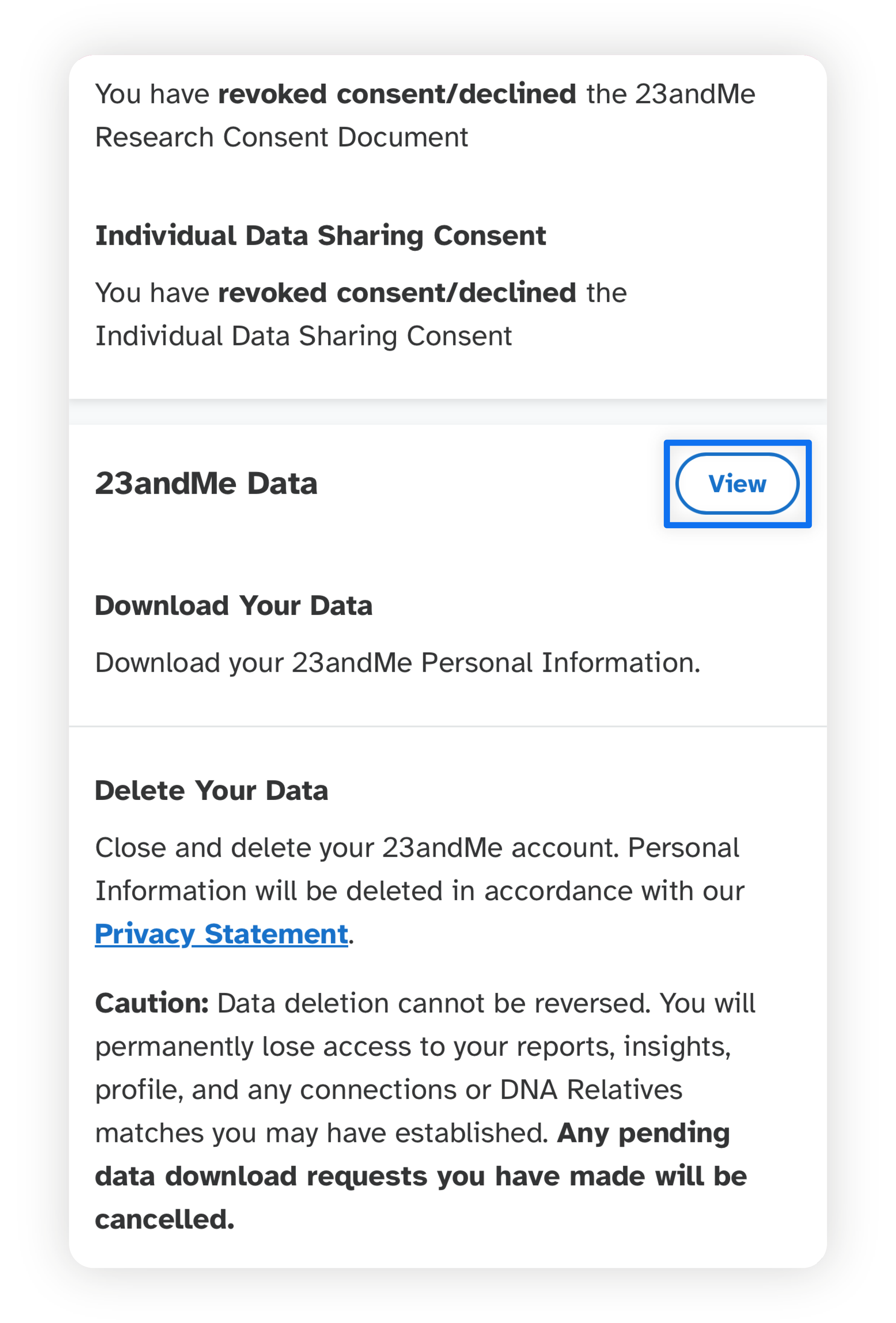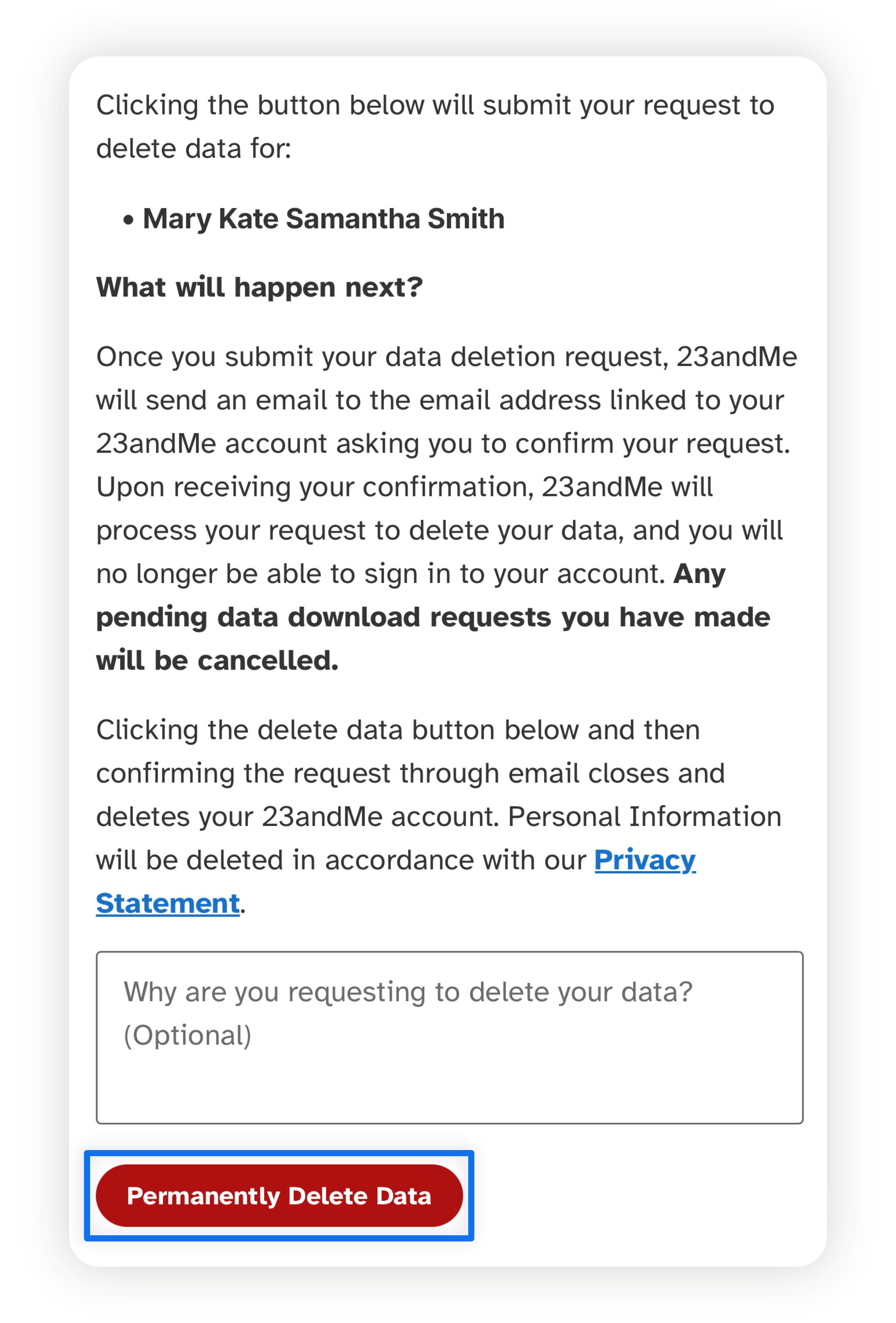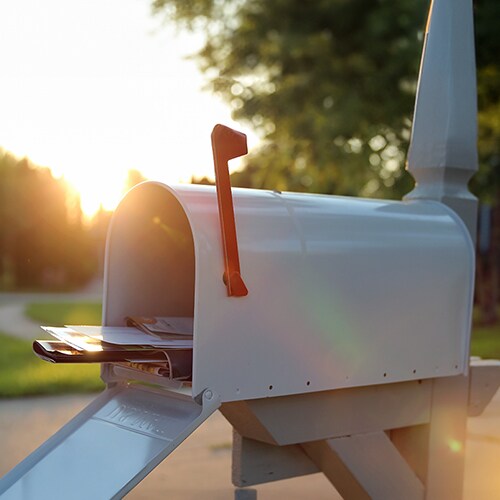Note: If you have issues downloading or deleting your 23andMe data, you can email the company’s Customer Care team at privacy@23andMe.com for assistance.
If you’re one of the 15 million people who’ve submitted their DNA to 23andMe, it’s time to pay attention. The popular genetic testing company, known for ancestry and health insights, filed for bankruptcy earlier this year.
23andMe (and the detailed DNA profile it created from your saliva sample) was recently sold to TTAM Research Institute, a nonprofit run by the company's co-founder.
And while TTAM says it will protect user data, 23andMe’s previous data breach and the lawsuits that followed have left many users unwilling to take the risk.
The safest move? Delete your 23andMe data by submitting a request to them directly. Here’s how to do it on your web browser, step by step.
1. Back up any data you want to keep
Before deleting your 23andMe account, make sure to download any information you’d like to hold on to. Here's how:
- Log in to your 23andMe account
- Navigate to Account Settings.
- Scroll to the 23andMe Data section and click View.
- From there, you can download your data in common, machine-readable formats like .txt and .csv.
The most important files to consider downloading include:
- Reports Summary: A high-level overview of all your 23andMe results.
- Ancestry Composition Raw Data: Genomic coordinates (NCBI Build 37) tied to your ancestry results.
- DNA Relatives Data: DNA segments and profile data used in the DNA Relatives feature.
- Raw Data: Your uninterpreted genetic data straight from the lab.
2. Permanently delete your data
Once you’ve downloaded everything you want to keep, you can request to permanently delete your data from 23andMe’s database. Here’s how:
- Click your username in the top right, then navigate to Account Settings.
- Scroll to the 23andMe Data section and click Delete your data.
- At the bottom of that page, click Permanently Delete Data.
- You’ll receive a confirmation message stating that your request was received, but it’s not official until you confirm via email.
- Open the email titled “23andMe Delete Account Request” and click the Permanently Delete All Records button.
- You’ll be redirected to a confirmation page that says, “Your data is being deleted.”




Once confirmed, you will have permanently removed your sensitive data from 23andMe’s systems. This includes your saliva sample, genetic reports, and raw DNA data.
3. Withdraw consent for future research
If you previously gave 23andMe permission to use your genetic data and sample for research, either by the company or third-party partners, you may want to withdraw that consent as well. Here’s how:
- Navigate to Account Settings.
- Under Research and Product Consents, view your current consent status.
- Click Change Consent if you wish to withdraw.
Withdrawing consent helps ensure your data isn’t used in future research, even if it was previously shared.
Deciding whether you should delete your 23andMe data
Deleting your 23andMe data helps protect your privacy in an industry where genetic information is often vulnerable and underregulated. While the company’s recent bankruptcy and sale have raised concerns about who now has access to users’ genetic information, this data privacy issue goes far beyond 23andMe.
DNA data stored by genetic testing companies, like other personal data, is vulnerable to hacking, data breaches, and unauthorized third-party sharing. Although it can’t be used to directly impersonate you, fraudsters could target DNA data to facilitate synthetic identity theft, according to ASIS International.
And right now, U.S. laws don’t offer strong protections tailored toward genetic information. In fact, concerns over this legal gray area recently led the U.S. Senate to propose the Genomic Data Protection Act, aimed at regulating how direct-to-consumer testing companies handle your most personal information.
Protect your personal data beyond 23andMe
Your genetic data is just one piece of the privacy puzzle. If any of your personal information falls into the wrong hands, your identity could be at risk. LifeLock can help with proactive identity protection that monitors for threats and alerts you to potential fraud.
FAQs
Why did 23andMe go bankrupt?
23andMe filed for bankruptcy largely due to ongoing financial struggles. As demand for at-home genetic testing declined, the company struggled to generate sustainable profits. Security concerns stemming from a previous data breach may have also contributed to a loss of trust and declining sales.
Can 23andMe sell your data?
Yes, after filing for bankruptcy, the court granted 23andMe permission to sell users’ genetic and medical data, according to a recent press release.
Should I delete my 23andMe data?
Yes, it’s recommended. In fact, California Attorney General Rob Bonta issued a consumer alert urging 23andMe customers to consider deleting their data due to privacy concerns.
Editor’s note: Our articles provide educational information. LifeLock offerings may not cover or protect against every type of crime, fraud, or threat we write about.
Related articles
Start your protection,
enroll in minutes.
LifeLock is part of Gen – a global company with a family of trusted brands.
Copyright © 2025 Gen Digital Inc. All rights reserved. Gen trademarks or registered trademarks are property of Gen Digital Inc. or its affiliates. Firefox is a trademark of Mozilla Foundation. Android, Google Chrome, Google Play and the Google Play logo are trademarks of Google, LLC. Mac, iPhone, iPad, Apple and the Apple logo are trademarks of Apple Inc., registered in the U.S. and other countries. App Store is a service mark of Apple Inc. Alexa and all related logos are trademarks of Amazon.com, Inc. or its affiliates. Microsoft and the Window logo are trademarks of Microsoft Corporation in the U.S. and other countries. The Android robot is reproduced or modified from work created and shared by Google and used according to terms described in the Creative Commons 3.0 Attribution License. Other names may be trademarks of their respective owners.





